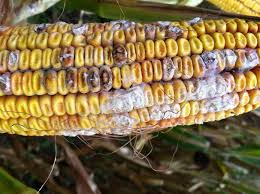Evaluation on reaction of early maturing maize lines and hybrids to fusarium ear rot
Keywords:
Early maturity, Genotypes, Fusarium ear rot, Maize, ResistanceAbstract
In order to investigate the amount of resistance in and early maturity lines and hybrids to ear rot fusarium disease, an experiment was caried out with 56 lines and 34 hybrids which were extracted from material corn and forage crop department were planted in Gharakhil agricultural research station in 2010-2011. Inter row space was 75 centimeters, row legth was 2/5 m and pland distance in row was 25 centimrters. By using artifical inoculation, all of gonotyps were inoculated by using scale rating, the rate of resistance was indentfied (Diseas severity) and the result in2010 showed that three lines were very suseptible, 11 lins were susceptible and others were tolorant. Two hybrids were susceptibl and others tolorant. Results in 2011 showed that five lines were susceptibleand12 lines were very tolorant. Hybrid, KE77007/14 × KE1264/5-1 was resistant, 31 hybrids were tolorant and one hybrid was susceptibl.References
Afolabi, C.G., Ojiambo, P.S., Ekpo, E.J.A., Menkir, A., Bandyopadhyay, R., 2007. Evaluation of maize inbred lines for resistance to Fusarium ear rot and fumonisin accumulation in grain in tropical Africa. Plant. Dis., 91, 279-286.
Desjardins, A.E., Munkvold, G.P., Plattner, R.D., Proctor, R.H., 2002. FUM1–a gene required for fumonisin biosynthesis but not for maize ear rot and ear infection by Gibberella moniliformis. Molecul. Plant. Microb. Interact., 15, 1157–1164.
Headrick, J.M., Pataky, J.K., 1989. Resistance to kernel infection by Fusarium moniliforme in inbred lines of sweet corn and the effect of infection on emergence. Plant. Dis., 73, 887-892.
Jeffers, D., Vasal, S.K., Mcclena, S., Srinivasan, G., 1994. Evolution of tropical inbred lines for resistance to Fusarium monilliforme ear rot. Maize Genetics Cooperation Newsletter, 68, 58.
Knop, M., Pacyna, S., Voloshchuk, N., Kant, S., Mullenborn, C., Steiner, U., Kirchmair, M., Scherer, H.W., Schulz, M., 2007. Zea mays: benzoxazolinone detoxification under sulfur deficiency conditions–a complex allelopathic alliance including endophytic Fusarium verticillioides. J. Chem. Ecol., 33, 225–237.
Kozic, Z., Palaversic, B., Buhinicek, I., 2002. Evaluation of the inbred line Bc 703_19 as a source of resistance to Fusarium stalk rot of maize. J. Appl. Genet., 43A, 255_258.
Lee, K., Pan, J.J., May, G., 2009. Endophytic Fusarium verticillioides reduces disease severity caused by Ustilago maydis on maize. FEMS Microbiol. Lett., 299, 31–37.
Marìn, S., Magan, N., Ramos, A.J., Sanchis, V., 2004. Fumonisin-producing strains of Fusarium: a review of their ecophysiology. J. Food. Protect., 67, 1792–1805.
Moretti, A., Corazza, L., Balmas, V., Santori, A., Ritieni, A., 2002. Funghi tossinogeni e micotossine: filiera cerealicola. Informatore Fitopatologico (Speciale Micotossine)12, 17–22.
Munkvold, G.P., 2003. Epidemiology of Fusarium diseases and their mycotoxins in maize ears. Eur. J. Plant. Pathol., 109, 705-713.
Munkvold, G.P., Desjardins, A.E., 1997. Fumonisins in maize. Plant. Dis., 81(6), 556–565.
Ochor, T.E., Trevathan, L.E., King, S.B., 1987. Relationship of harvest date and host genotype to infection of maize kernels by Fusarium moniliforme. Plant. Dis., 71, 311-313.
Patel, S., Hazel, C.M., Winterton, A.G.M., Gleadle, A.E., 1997. Surveillance of fumonisins in UK maize-based foods and cereals. Food. Addit. Contam., 14(2), 187–191.
Rossi, V., Scandolara, A., Battilani, P., 2009. Effect of environmental conditions on spore production by Fusarium verticillioides, the causal agent of maize ear rot. Eur. J. Plant. Pathol., 123, 159–169.
Rumbeiha, W.K., Oehme, F.W., 1997. Fumonisin exposure to Kansans through consumption of corn-based market foods. Vet. Human. Toxicol., 39(4), 220–225.
Stewart, D.W., Reid, L.M., Nicol, R.W., Schaafsma, A.W., 2002. A mathematical simulation of growth of Fusarium in maize ears after artificial inoculation. Phytopathol., 92, 534-541.
Vigier, B., Reid, L.M., Seifert, K.A., Stewart, D.W., Hamilton, R.I., 1997. Distribution and prediction of Fusarium species associated with maize ear rot in Ontario. Can. J. Plant. Pathol., 19, 60-65.
Voss, K.A., Bacon, C.W., Meredith, F.I., Norred, W.P., 1996. Comparative subchronic toxicity studies of nixtamalized and water-extracted Fusarium moniliforme culture material. Food. Chem. Toxicol., 34, 623–632.
White, D.G., 1999. Compendium of Maize Diseases, 3rd ed. Am. Phytopathol. Soc., St.Paul, MN.
Wit, M., Warzecha, R., Mirzwa-Mróz, E., Ochodzki, P., Waskiewicz, A., Wakulinski, W., 2010. Susceptibility of flint and dent maize ears to Fusarium species. Phytopathol., 60, 35-45.

Published
How to Cite
Issue
Section
Copyright (c) 2020 M. Mohseni, M.H. Haddadi, M. Zamani

This work is licensed under a Creative Commons Attribution-NonCommercial-NoDerivatives 4.0 International License.



